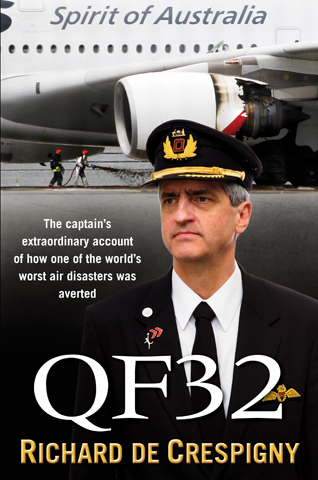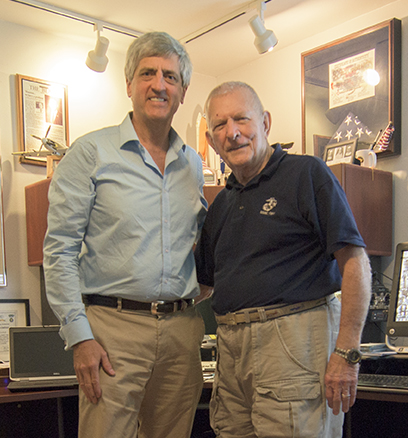Photos of the QF32 Cabin Crew
are at QF32 page 279
Photos of the QF32 Technical Crew

The QF32 pilots provide a NASA style basic overview address to a private audience of A380 pilots and senior management three weeks after the QF32 event. (Photo R de Crespigny)

Matt, Harry, Richard, Dave, Mark at lunch the next day (page 303)
(Photo courtesy Richard de Crespigny)
QF32 event occurred at about noon on Thursday 4th November 2010.
This photo was taken 24 hours later on the Friday.
I had to buy a fresh set of clothes (and a new phone charger) as soon as the shops opened as my luggage did not arrive to my room until 30 hours after the QF32 flight, and five minutes before I left the hotel to return home to Australia!
I discovered that of all my possessions, it was the mobile phone that became the most important asset in the hours and days after the event. And so the lack of a phone charger (because it was in my missing suit case) became a major issue when trying to maintain communications.
More photos of the pilots are at QF32 page 278
Michael von Reth
Read more about Michael Von Reth
QF32 Afterparty – 1 April 2011
Other Photos
I am a keen amateur photographer. Here are two photos of models in 1940s period Qantas uniforms. It does not get more nostalgic than this.
The crew of the delivery flight of our fourth aircraft (VH-OQD) from Singapore to Sydney (August 2009). It’s in this type of photo that you gain the perspective of the Trent 900’s (72,000 pound thrust / 82,500 hp) enormous size.
Please note
Many more photos and back stories have been queued to be published. Subscribe to these posts by entering your eMail address (at home page, right hand side, just under the book cover image)
Richard believes it unfortunate that some versions of the QF32 book (translated into other languages) do not contain the excellent 63 photos that are published in the English version of QF32.












Hi Richard
Just finished your book, an absolutely brilliant read. I’ve been a planespotter for 50+ years and my earliest QF memories are seeing fog diverted 707 V-Jets at Manchester!
Just one question……..in the book you say Dave failed you as Check Captain……why?
Cheers
Paul (now in NZ)
Hi Captain
A great book and such an insight. I still have my copy from a few years ago and I intend to read it again.
My question is are the flight crew on QF32 that day still flying for Qantas?
My apologies if this has been asked previously.
Kind Regards
David
David, all pilots are still flying in Qantas. Most of the 24 cabin crew are still flying in Qantas. Rich
The hydraulics, electrics, brakes, fuel, flight controls and landing gear systems were all compromised. During all of this, de Crespigny and his crew focused on keeping the plane at a controlled speed and above nearby mountains.
Rich,
I used to work for the FAA in Washington. I’m the guy who wrote the COBOL reporting programs for management information publications to reflect U.S. airport activity for management planned staffing of towers.
I first flew from Boston to Washington (in Dec 1946) in a non-pressurized DC-6A with General Patton’s widow aboard. She came up to my Mom and stated she wished she could get her grandchildren to fly alone like I had. We didn’t know who she was but saw her picture in the paper the next day.
I returned Boston on a good old American Airlines one-class DC-3, which landed on grass at New Haven, on ice at Boston.
Great job, Captain. Many more happy years to you.
Robert Palmer, Bangor Maine USA
Thanks for your stories Rob.
Thank you for your toils – they are appreciated every day I fly. You were part of the honoured profession of aviation that about seventy years ago started revolutionising communications world-wide. Yours is also a remarkable generation that contributed to everything that is great in aviation.
Eugene Kranz – NASA
For your interest, I was honoured to interview Eugene Kranz yesterday in Houston. Gene is also of your generation, a famous but modest (it was never about him – it was always about his team) Flight Director for NASA’s Mercury, Gemini and Apollo missions. Gene then went on to become the Deputy Director of NASA Mission Operations (during the early Space Shuttle flights). Gene represents everything in leadership that is dynamic, powerful, laden with threats, risk aware and successful.
Gene and his colleagues took the entire world along with them and NASA’s astronauts on live TV in the 1960s, surfing along the edges of chaos on NASA’s high risk, high tech discovery tour of exploration and adventure to the moon. There has never been any event (other than war) since the Mercury, Gemini and Apollo projects that mobilised a world together and achieve so much as a consequence.
NASA’s policies of disclosure, media involvement and crisis management remain the ideal practices today.
Gene’s lessons for resilience and leadership were part of the “Right Stuff” culture that served him, the astronauts and Gene’s 400,000 colleagues so well at NASA in the 1960s. I discuss Gene’s expectations for “tough and competent” that he espoused in the 1960s when I present to corporates. His values, beliefs are even more relevant today in our risk averse world where ideas are free, but leadership, teamwork and execution are priceless.

The Numbers of Apollo and Flight
Rob I hope that you are on my next flight when I fly the longest route in the world from Dallas to Sydney. If you are interested, we’ll be at our max takeoff weight of 569 tonnes (1.25 million pounds) for takeoff when we embark on our 8,000 air nm (14,800 air km) route that will take up to 17 hours to fly. We will load about 400 passengers and 330,000 kg (412,000 litres or 108,000 US Gallons) of fuel. That’s enough fuel to fill a family car once a week for its driver’s life.
If these fuel quantities are daunting, then consider that they are dwarfed by Apollo:
A World Challenge to equal Apollo
I suggest a challenge today that could rival the challenge that the Apollo project met 45 years ago. If our leaders dedicate themselves politically, economically and socially to harvesting renewable energies with the grit and determination that the USA applied to space exploration in the 1960s, then our world could transition to having almost free energy that could be used to synthesise unlimited clean liquid fuels.
Thanks Aviators, FAA, Gene Kranz and NASA
Thanks for the memories Rob. I’ve had a great pleasure in thinking about the contributions that you, your FAA colleagues, Gene Kranz and NASA made to our planet.
You made a difference. You disrupted the world fifty years ago, opening communications, flattening the world, indeed flattening space to the same degree that the internet has changed our lives and made world commerce frictionless today.
You all made aeronautics and astronautics so much safer for the travelling public.
Please say hi to me if you ever hear me on the public address on your next flight.
Safe flying and best regards
Rich
Dear Capt Richard,
I just finished reading your book for the 2nd time. So much appreciation has been showered on you over the past days that, it will be fruitless to add any more to it.
I have a question for you. You have mentioned at the end of the book, that you didn’t pass the route check on the QF32 flight on 4th Nov 2010. Why were you failed, when everything was done so correctly? Did you have to complete another route check to become certified again?
Thank you so much
Dear Sitikantha,
Route Checks must be completed every twelve months. I technically had to repeat the route check because I did not pass that route check on 4 Nov 2010. However I continued to fly through 2011 and the next route check was not conducted until November 2011.
Rich
Thank you so much for writing this book; an Amazing Story and it’s great that you could share it with everyone.
Also I really like planes and that’s why I decided to get this book.
I had to write a report on it at the end of August and I got Top marks. So thank you so much for helping me with that.
I was at Sydney Qantas Domestic Terminal last week and visited the Qantas Heritage Museum next to Gate 13.
The flight attendant uniforms from Qantas’ beginnings until the present are displayed in the museum. So interesting to see!
Every time I see a Qantas A380 taking off and landing now, I wonder if it is you, Richard, at the controls! How many flights per month does a captain do on the A380?
Hi Mandy,
Thanks for your positive comments.
The Qantas Heritage Museum at the Sydney Qantas Domestic Terminal is a remarkable assembly of aviation memorabilia that traces aviation’s remarkable achievements since 1920. For other readers, this museum is well worth a visit.
I was privileged to be allowed to photograph models dressed in the real QF 1940’s uniforms.
The cabin attendants and their uniforms need qualification. The attendants were a beautiful, tough and an impressive breed. Aviation’s first cabin attendants were usually female, often had nursing qualifications and had to be strong enough to help the pilots and engineers pull/push their aircraft from/into hangars. Before WWII, they often lined up and saluted the pilots as the pilots entered the aircraft!
I have been told lots of stories about those early years, lots about “Trixy” and “Bubbles”. I could never publish most of these stories, but they nevertheless provide great entertainment around the campfire.
A380 long-haul pilots (similar to 747 pilots) fly about six sectors per month. We share the landings with our first officers, and so the average pilot only gets about three landings per month! This low rate should be put into context with the type of flying that long haul pilots conduct. Here are the air nautical mile distances for our routes: (These distances change with the prevailing winds on their respective routes. Multiply by 1.85 to convert to kilometers)
SYD-LAX 6,108 anm
DBX-SYD 6,317 (DBX = Dubai)
SIN-LHR 6,328
LAX-BNE 6,382
SYD-JNB 6,401 (JNB = Johanesburg)
MEL-LAX 6,439
MEL-DBX 6,657
SYD-DBX 6,607
LAX-SYD 6,939
LAX-MEL 7,267 (Flight time of 15 hours and 40 minutes!
Australian pilots are also limited to (100 hours in 30 days) and 900 hours (in the pilots seat) per year. We regularly approach (but never exceed) the first limit!
Best Regards Rich
Excellent Crew photos….simply Brilliant !!